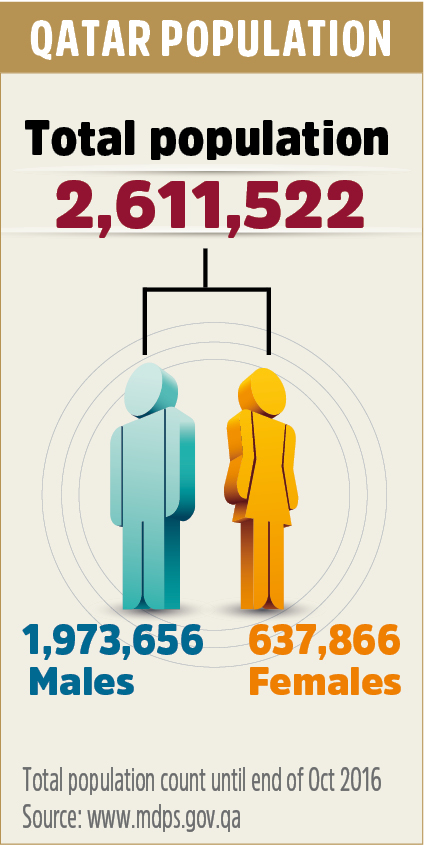2,866,279
|
Qatar Population (1950 – 2020)
196019601970197019801980199019902000200020102010….750,000750,0001,500,0001,500,0002,250,0002,250,000Qatar PopulationQatar Population
|
||||||||||||||||||||||||||||||||||||||||||||||||||||||||||||||||||||||||||||||||||||||||||||||||||||||||||||||||||||||||||||||||||||||||||||||||
|
Yearly Population Growth Rate (%)
196019601970197019801980199019902000200020102010….5510101515Yearly Growth Rate (%)Yearly Growth Rate (%)
|
- The current population of Qatar is 2,865,998 as of Thursday, March 12, 2020, based on Worldometer elaboration of the latest United Nations data.
- Qatar 2020 population is estimated at 2,881,053 people at mid year according to UN data.
- Qatar population is equivalent to 0.04% of the total world population.
- Qatar ranks number 139 in the list of countries (and dependencies) by population.
- The population density in Qatar is 248 per Km2 (643 people per mi2).
- The total land area is 11,610 Km2 (4,483 sq. miles)
- 96.2 % of the population is urban (2,770,452 people in 2020)
- The median age in Qatar is 32.3 years.
Population of Qatar (2020 and historical)
| Year | Population | Yearly % Change |
Yearly Change |
Migrants (net) | Median Age | Fertility Rate | Density (P/Km²) | Urban Pop % |
Urban Population | Country’s Share of World Pop |
World Population | Qatar Global Rank |
|---|---|---|---|---|---|---|---|---|---|---|---|---|
| 2020 | 2,881,053 | 1.73 % | 48,986 | 40,000 | 32.3 | 1.88 | 248 | 96.2 % | 2,770,452 | 0.04 % | 7,794,798,739 | 139 |
| 2019 | 2,832,067 | 1.81 % | 50,385 | 40,000 | 31.6 | 1.98 | 244 | 96.1 % | 2,721,608 | 0.04 % | 7,713,468,100 | 141 |
| 2018 | 2,781,682 | 2.09 % | 56,954 | 40,000 | 31.6 | 1.98 | 240 | 96.0 % | 2,671,546 | 0.04 % | 7,631,091,040 | 142 |
| 2017 | 2,724,728 | 2.65 % | 70,354 | 40,000 | 31.6 | 1.98 | 235 | 96.0 % | 2,614,873 | 0.04 % | 7,547,858,925 | 142 |
| 2016 | 2,654,374 | 3.46 % | 88,664 | 40,000 | 31.6 | 1.98 | 229 | 95.9 % | 2,544,480 | 0.04 % | 7,464,022,049 | 142 |
| 2015 | 2,565,710 | 6.69 % | 141,877 | 120,970 | 31.5 | 2.00 | 221 | 95.7 % | 2,455,353 | 0.03 % | 7,379,797,139 | 142 |
| 2010 | 1,856,327 | 16.49 % | 198,182 | 182,920 | 31.6 | 2.23 | 160 | 94.4 % | 1,752,996 | 0.03 % | 6,956,823,603 | 148 |
| 2005 | 865,416 | 7.87 % | 54,590 | 42,783 | 31.0 | 2.95 | 75 | 97.3 % | 842,340 | 0.01 % | 6,541,907,027 | 158 |
| 2000 | 592,468 | 2.90 % | 15,805 | 5,901 | 30.5 | 3.46 | 51 | 96.3 % | 570,417 | 0.01 % | 6,143,493,823 | 164 |
| 1995 | 513,442 | 1.51 % | 7,433 | -2,026 | 29.0 | 3.74 | 44 | 95.0 % | 487,771 | 0.01 % | 5,744,212,979 | 164 |
| 1990 | 476,278 | 5.13 % | 21,078 | 11,503 | 28.7 | 4.40 | 41 | 92.8 % | 442,074 | 0.01 % | 5,327,231,061 | 164 |
| 1985 | 370,890 | 10.65 % | 29,452 | 20,419 | 26.9 | 5.45 | 32 | 90.1 % | 334,343 | 0.01 % | 4,870,921,740 | 164 |
| 1980 | 223,632 | 6.36 % | 11,862 | 5,677 | 23.4 | 6.10 | 19 | 89.4 % | 199,973 | 0.01 % | 4,458,003,514 | 176 |
| 1975 | 164,320 | 8.45 % | 10,961 | 6,874 | 23.2 | 6.75 | 14 | 89.0 % | 146,177 | 0.00 % | 4,079,480,606 | 177 |
| 1970 | 109,514 | 8.26 % | 7,176 | 4,212 | 22.0 | 6.97 | 9 | 88.4 % | 96,760 | 0.00 % | 3,700,437,046 | 184 |
| 1965 | 73,633 | 9.22 % | 5,250 | 3,279 | 20.5 | 6.97 | 6 | 87.1 % | 64,100 | 0.00 % | 3,339,583,597 | 201 |
| 1960 | 47,384 | 5.73 % | 2,304 | 911 | 19.4 | 6.97 | 4 | 85.3 % | 40,407 | 0.00 % | 3,034,949,748 | 197 |
| 1955 | 35,866 | 7.48 % | 2,173 | 1,137 | 19.4 | 6.97 | 3 | 83.0 % | 29,779 | 0.00 % | 2,773,019,936 | 201 |
Source: Worldometer (www.Worldometers.info)
Elaboration of data by United Nations, Department of Economic and Social Affairs, Population Division. World Population Prospects: The 2019 Revision. (Medium-fertility variant).
Qatar Population Forecast
12,000
| Year | Population | Yearly % Change |
Yearly Change |
Migrants (net) | Median Age | Fertility Rate | Density (P/Km²) | Urban Pop % |
Urban Population | Country’s Share of World Pop |
World Population | Qatar Global Rank |
|---|---|---|---|---|---|---|---|---|---|---|---|---|
| 2020 | 2,881,053 | 2.35 % | 63,069 | 40,000 | 32.3 | 1.88 | 248 | 96.2 % | 2,770,452 | 0.04 % | 7,794,798,739 | 139 |
| 2025 | 3,121,705 | 1.62 % | 48,130 | 26,000 | 33.6 | 1.88 | 269 | 96.5 % | 3,010,901 | 0.04 % | 8,184,437,460 | 137 |
| 2030 | 3,326,890 | 1.28 % | 41,037 | 21,000 | 35.3 | 1.88 | 287 | 96.7 % | 3,216,779 | 0.04 % | 8,548,487,400 | 136 |
| 2035 | 3,497,397 | 1.00 % | 34,101 | 17,000 | 37.1 | 1.88 | 301 | 96.9 % | 3,389,037 | 0.04 % | 8,887,524,213 | 137 |
| 2040 | 3,628,685 | 0.74 % | 26,258 | 12,000 | 38.7 | 1.88 | 313 | 97.1 % | 3,524,170 | 0.04 % | 9,198,847,240 | 137 |
| 2045 | 3,746,735 | 0.64 % | 23,610 | 12,000 | 40.1 | 1.88 | 323 | 97.4 % | 3,648,803 | 0.04 % | 9,481,803,274 | 133 |
| 2050 | 3,851,131 | 0.55 % | 20,879 | 41.4 | 1.88 | 332 | 97.7 % | 3,762,103 | 0.04 % | 9,735,033,990 | 134 |
Source: Worldometer (www.Worldometers.info)
Elaboration of data by United Nations, Department of Economic and Social Affairs, Population Division. World Population Prospects: The 2019 Revision. (Medium-fertility variant).
Qatar Demographics
Main Page: Demographics of Qatar
LIFE EXPECTANCY
80.73 years
(life expectancy at birth, both sexes)
View by sex and historical chart
View by sex and historical chart
INFANT MORTALITY
5.5
(infant deaths per 1,000 live births)
View historical chart
View historical chart
DEATHS UNDER AGE 5
6.7
(per 1,000 live births)
View historical chart
View historical chart
Main Cities by Population in Qatar
(includes boroughs, districts, urban agglomerations, etc.)
| # | CITY NAME | POPULATION |
|---|---|---|
| 1 | Doha | 344,939 |
| 2 | Ar Rayyan | 272,465 |
| 3 | Umm Salal Muhammad | 29,391 |
| 4 | Al Wakrah | 26,436 |
| 5 | Al Khawr | 18,923 |

























